The Killing of Ellen Barratt, of Aspley Guise, in 1856
WARNING: The following history research contains descriptions of child abuse. I have left the newspaper reports transcriptions unedited so the whole story is told.
In March 1856, a young girl died during the night in Aspley Guise. This is not an unusual event for the time, given that unchecked diseases spread easily, and the inability of the poor to afford even the most basic medical treatment for minor infections. However, it was soon discovered that this death was down to the neglect and abuse by the girls’ own parents and elder sister. The terrible story that came out at the trial was reported in nearly all the national and local papers of the time, and horrified the whole country. The image we have today of the smiling, immaculately-dressed, spinster ladies quietly making lace in homely country cottages is not an accurate reflection of the times. Many families struggled to make ends meet, and as soon as children were old enough to sit up and be taught, they were put to work lacemaking or straw plaiting. When the local lace dealer came around at the end of the week, they were paid for each yard they had produced. Water-filled glass bulbs were used to magnify the available light, so four people could use the light of just one candle, continuing to make delicate lace, long after the sun had gone down.
In the 1851 census of nearby Newport Pagnell, of the c.800 women who gave an occupation, 316 described themselves as lace makers. There were lace schools, and girls as young as five were taught. The lace dealers supplied the patterns to work from, but the lacemakers had to buy their own thread. Once the Education Act of 1870 made proper schooling compulsory, this child labour gradually died out.
The 1851 census data for Aspley Guise was analysed in “The Story of Aspley Guise”, published by the Woburn Sands District Society in 1980. Therefore, we know that the Barratts lived in West Street. (The spelling of the surname varies in different sources as either Barratt or Barrett.) Their cottage was just at the entrance to Wood Lane. Samuel Barratt and Susanna Davis had married in June 1819, and were living there with nine of their children, (Elizabeth aged 24; Ann 22; Susanna 17; Benjamin 16; Eliza 13; Ellen 11; Charlotte 9; Julia 7 and Thomas 5) but another two elder siblings had already moved out. All their children had been born in Aspley Guise. Samuel was a shepherd, while his wife and six of his daughters are listed as lacemakers, but Eliza had no trade listed. His elder son was a labourer.
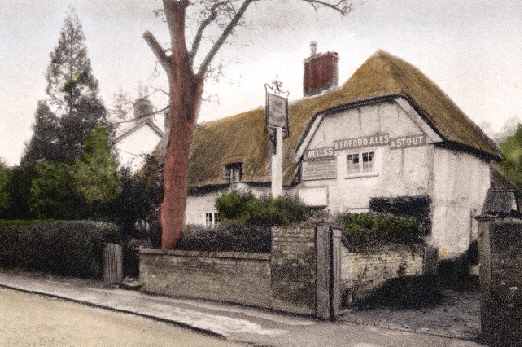
The first record of this dreadful event comes from the Bedford Mercury, who reported, on 5th April 1856, that an inquest had been convened at a local inn:
“HORRIBLE CASE OF STARVING TO DEATH. An inquest was held at the Steamer beershop at Aspley on the 1st of April before Mr W. Wiseman esq., deputy coroner for the Honor of Ampthill, on the body of Ellen Barrett, about 12 years old, who was found dead in bed on the 30th alt. The evidence went to prove to all the parents elder children were in good condition but the younger ones were in a frightfully emaciated condition, and it appeared that this must have resulted from the parents having kept them morning, noon, and night fixed to the “lace pillow” and feeding them with gruel for breakfast, gruel for dinner, gruel for supper with an occasional modicum of bread; but no air, no exercise, no amusement, no relaxation: nothing but work, work, work, until the bodies of the poor things were wasted literally to skeletons. The jury returned a verdict of manslaughter against the unnatural parents, and they were committed to Bedford Gaol for trial at the next assizes.”
The investigation into the cause of death was quickly broadened and implicated Ellen’s elder sister, Elizabeth, as an accomplice. The younger sisters were the main source of evidence of the appalling treatment they had all been receiving. Elizabeth was brought up to the Woburn Petty Sessions to be committed for trial. The Bedford Mercury again, 24th May:
“HORRIBLE INHUMANITY AND MANSLAUGHTER OF A CHILD BY ITS RELATIVES. It will be in the recollection of our readers, that about 5 weeks since we reported an inquest held at Aspley Guise on the body of Ellen Barrett a child 12 years old, who died from starvation and neglect and the committal of the unnatural parents for trial of the next sizes for the crime of manslaughter by the coroner’s jury. Since that event the tongue of rumour has been very busy with the case which caused further investigation, and which resulted in Superintendent Young apprehending Elizabeth Barrett, aged 29, the eldest sister, charged with being an accessory to the death. The following evidence was adduced against her, the witnesses being her own sisters: –
Charlotte Barrett, the first witness, apparently 6 or 7 years old, stated that she was 14 years of age. Her sister Ellen died on a Sunday morning about 5 o’clock, March 30th; she had been kept at work constantly even up to 5 o’clock on the Saturday night, notwithstanding her complaints, and was then driven to bed without any supper, having had nothing all day, her mother beating her with her stays up stairs because she asked for something to eat; she kept awake nearly all night, and about 1 o’clock in the morning made a noise; her mother came into the room and hit her; and told her to lie still; after that she mourned, but soon she attempted to sing a hymn, and afterwards prayed – “Lord Jesus, let me do my work next week;” these were the last words she spoke, and she died soon after. Me and my sisters were kept at work lacemaking 14 hours a day, with a quarter of an hour for breakfast, and 20 minutes for dinner; that was all the stoppage or rest we had; and if we finished our work at night we had some gruel or bread and dripping for supper; we had garden stuff or gruel for dinner, when we had any, and sometimes pudding; if our task of work was not done at night we were sent to bed without supper, and had to get up the next morning and stand naked in the cold till we finished our task, without breakfast. Mother and sister often boiled up the coffee grounds for our breakfast, and gave us a piece of bread so big (about 2 inches square); we never had as much as we could eat, nor enough; prisoner has often held us while mother beat us; she has stuffed rags into our mouths to prevent us from crying; two of my teeth have been knocked out in this way. My sister (the prisoner) has held us while my mother has put sheep dung, cow dung, and rabbit dung into our mouths, and even the filth from her snuffy pocket-handkerchief she has made us eat; and my sister has held us while. We were often made to sit with our sore flesh upon nettles and thistles which were put in our chair; we never had any fire in our work room, but there was a fire in mother’s room, where she and my sister were, but if we went in there, we were turned out directly. I have been often beaten with nettles; we have been made to eat pig’s victuals; poor Ellen has been kept two or three days together without food, because she could not do her work; my sister always helped my mother against us.
Julia Barratt apparently about six or seven years of age but who stated her age to be twelve, confirmed all that the last witness had said, and added that even when her mother had given her a little bit of bread, the prisoner had snatched it away from her. She had frequently been kept without food when she could not do her work, and made to stand naked in a cold room without breakfast until she had done it. She had been beaten with nettles and thistles, and made to sit on them bare, and prisoner has pulled up our clothes to sit us on them; when we have had cow and other dung put into our mouths, sister has stuffed our mouths with rags if we cried out. A few days before Ellen died, she had three fits, and fell down. My sister picked her up and set her to work again directly. On the Friday night before she died, she was sent to bed without supper, and on Saturday she had a little gruel for dinner. On Saturday night she was sent to bed without supper, and beat. She died in the night.
Susannah Barratt, apparently about 14, stated her age to be 22. She had heard what her sisters said, and it was true. She had been served in the same manner.
Dr Williams proved that he had made a post mortem examination of the body of Ellen Barratt. The body was remarkably small, the face small and idiotic, shrivelled and monkey-like. There was no appearance of disease, but the lungs appeared as if they had not been much used. There was very little blood in the system at all. The heart was quite empty. The small quantity of blood there was, was of a watery character. The stomach contained a little gruel – not an ounce – and nothing else. I could hardly distinguish the stomach from the small intestine. It was no bigger than that of a child five years’ old. In my opinion overwork and insufficient nourishment with the treatment I have heard today, would be sufficient to cause death.This concluded the case.
The prisoner, on being asked if she had anything to say, denied the whole of the charges. The prisoner was committed for trial. The case on behalf of the prosecution was conducted by C. R. Day, Esq., of Woburn.”
The case outraged the British public. When Samuel, Susannah and Elizabeth Barratt came to court, further details were reported in the press, with several columns dedicated to it in The Bedfordshire Times. They reported on 19th July:
“As this case has exalted a great amount of horror and indignation throughout the country, and we give the trial as fully as possible. The male prisoner appeared very hard working, but a sullen and close man; the wife was the very ideal of misery and griping avarice, but certainly appeared to have starved herself almost as much as her hapless children. The daughter was, to the eye, selfishness personified, and seemed to have thrived wonderfully in the midst of such unheard of privations inflicted on the younger sisters”
The younger sisters gave evidence that they worked 14 hours a day and had to produce five feet of narrow lace, or a little less if of the wider variety, every day. They sometimes went to school on a Sunday. They were beaten with a cane and a stick at home, as well as being tortured with the other methods previously described. They had been allowed a fire in their work room for just two days in the whole of previous winter. The family sold the lace for 6d. a yard of thin lace, or 8d. a yard of wide. Elizabeth had been saving the money up, and had 3 or 4 sovereigns hidden in a tea chest. Sovereigns had a nominal value of £1, but made of gold, they were seen as investments.
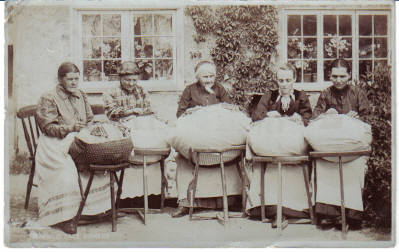
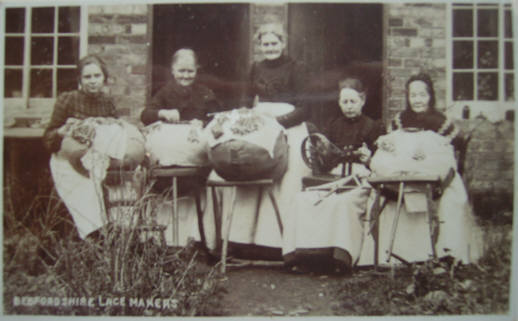
The younger children were questioned about why their evidence had changed since the committal proceedings. They said they had not told the full truth about the circumstances at home, as their mother and sister had threatened them on the way there. At that time, they did not even know their own true ages, but they had since learned how old they really were. Charlotte was actually 16, not 14 as she previously thought, and Julia was 15, not 12. Their Baptismal Register entries were produced in Court to prove this. Mr Power acted for the prosecution, and but the prisoners had no defence lawyer. Possibly, they could not afford one, or no-one wished to take the case.
After the original inquest and before her arrest, Elizabeth had arranged for all the household furniture to be removed from their house in Aspley Guise and taken to her brother’s house in Husborne Crawley. George Kemp, a publican from Woburn, had assisted with this move, and said Elizabeth had paid him two half crowns from a handful of money that contained about 20 gold coins. He had also seen plenty of evidence of the wealth of the family, with numerous fine possessions and quantities of food in the house, so poverty could not be the reason for their behaviour.
With their parents and elder sister in prison, poor Charlotte and Julia had been taken off to Woburn Workhouse. Even that must have been more welcome than their previous life at home. The Workhouse Master, William Henry Davies, stated to the Court that since they had been in his care, they had had only the usual diet of the workhouse. Yet even those meagre portions had strengthened the girls, as they weighed 46½ & 39lbs respectively when they arrived there, and within three weeks were 64¼ and 54lbs.
In her defence, Susannah said she had not been able to afford food for the whole family, and had often gone without food herself, so her children might eat. What the children had said was barley meal gruel had actually been good oatmeal. The work produced by the children had been sold for no more than £1 for six weeks’ work. Elizabeth muttered something in court that the reporter could not quite hear, but he thought it centred on the fact that the children used to ‘cheat’ at their work.
Samuel’s defence was that he was ignorant of the brutality meted out by his wife and elder daughter. He said he went off to work as a shepherd early in the morning, taking his son with him, and only returned late in the evening, and thus he had not known about the treatment of his younger children. His workplace was sometimes nine miles away from home. He earned 9s. 6d. for a week’s work, but his son got just 1s. 6d.
When Justice Coleridge summed up, he told the jury that if they believed the father gave the funds of his work to his wife to run the household as she saw fit, they could acquit him, or should say if they gave any distinction in his favour. As to the wife and daughter, they both seemed to have control of the children and had caused the death by neglect.
After a short consultation, the jury found all three guilty, but recommended the father to mercy. The Judge remarked that there was no sign the death was from lack of money in the family, or even that the family had been too proud to ask for help. He thought that the “…cruelty must have proceeded from hardness of heart or a wicked love of hoarding up money…”.
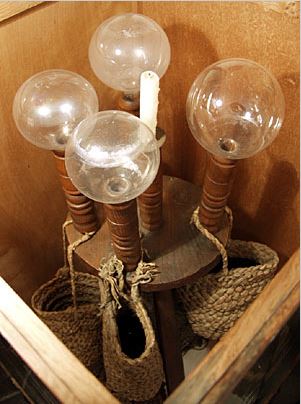
Addressing the mother and daughter, the Judge said, “I do trust that both of you, so long as you shall live, will pass some portion of every day in sincere regret and penitence for the deed you have done, the cruelty of which you have been guilty.”
The Judge then sentenced Samuel to twelve months’ hard labour, and both Susannah and Elizabeth to four years’ penal servitude.
Samuel Barrett’s entry in the Bedford gaol register from 2nd April gives us a few details about him. He was born in North Crawley, about 1791, was 5ft. 7in. in height, with grey hair, thinning on top, and grey eyes. It described him as having a long face and fresh complexion. He had a cut mark under his left eyebrow and another under his chin, and scars on his right knee and leg. His trade was given as Labourer, and he could neither read or write. It also records he was a father to 11 children.
Susannah Barrett’s entry says she was born about 1792 in Wardington, Oxon. She was 5ft. 5½in., grey haired with hazel eyes. She had an oval face, with a fresh complexion. Like her husband, she was listed as a Labourer who could neither read or write.
Elizabeth Barratt was entered into the prison register on 17th May. She was 28 years old, 5ft. ¼in. tall, brown haired and grey eyed. Like her mother, she had an oval face with a fresh complexion. She gave her occupation as lacemaker. Unlike her parents, Elizabeth had learned to read. Strangely, she gave her address as Husborne Crawley.
Mother and daughter stayed together at Bedford prison until the end of November, and were then transferred to Millbank prison in London. This was used to evaluate all prisoners to see where they would be sent to serve their sentences, and therefore they were both moved on to Brixton prison in October 1857. Conditions for women were especially harsh there, as newly-arrived female inmates spent four months in solitary confinement and, following their introduction into the general prison population, would be required to maintain a condition of silent association. They were allowed over time to earn privileges, which included limited conversation, payment for labour, the right to receive letters and visitation rights.
Once Samuel and Susannah had served their sentences, they were back in the area in time for the 1861 census. They had moved to Weathercock Lane, between Woburn Sands and Aspley Guise, and were living there with their youngest son, Thomas, who was now 14 and described as ‘at work in brickyard’.
They were still there in 1871, with a 50-year old Woburn-born agricultural labourer, Jonas Daniels, visiting them. Despite being 82 and 79, they are still listed with trades of ‘Sheppard’ and ‘Lacemaker’, so must still have been working to make ends meet. Samuel died in March 1875, aged 87 and Susannah in December 1876, aged 85, and were both buried at St Michael’s in Aspley Heath. There is no stone to mark them.
Facts about Elizabeth after she was released are few. She possibly lived with Ann, her sister, who had married Charles Clare, a stationary engine driver, of Woburn by 1861. They lived in Wing Road, Linslade. A later census records an Elizabeth living with them gave her profession as sempstress (seamstress).
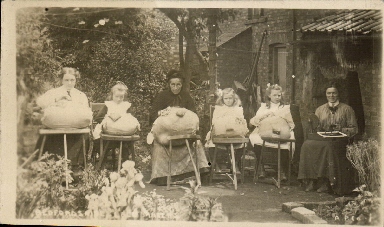
Of the other children, very little can be found. A sad postscript of Charlotte Barratt was identified by a research website from Hertford College, called “Lace in Context” [http://laceincontext.area.ox.ac.uk/ – currently unavailable] in the Bedford Times, of 7th July, 1860, when it appears she stole property from her brother-in-law:
“Bedfordshire Midsummer Quarter Sessions. Woburn. Stealing Money, etc. Charlotte Barratt (18), lace maker, was charged with stealing a purse containing 30s., a chisel, and a small table knife, the property of Charles Clare, on the 23rd of June. The prisoner pleaded guilty. Superintendent Young informed the court that the prisoner was in a destitute condition, and he did not believe that she was quite right in the head. Sentenced to three months’ imprisonment.”
By 1871, it appears that Charlotte had married an Aaron Gates, who was 27 years her senior, and was living in Tebworth. He, a labourer, and she a straw plaiter, with their two sons and two daughters. Aaron died 1876, and she then moved to Toddington to be a servant (1881). Another 10 years on, (1891) and she is a servant at 6-8 Park Street, Luton, and still with one of her sons living with her. Her employer then moved back to Toddington, and she is there in 1901. There is no trace in 1911, so I presume she had died by then.
My thanks to Dianne Sutton for the excellent family history detective work used in this research.
Page last updated Feb. 2020.
